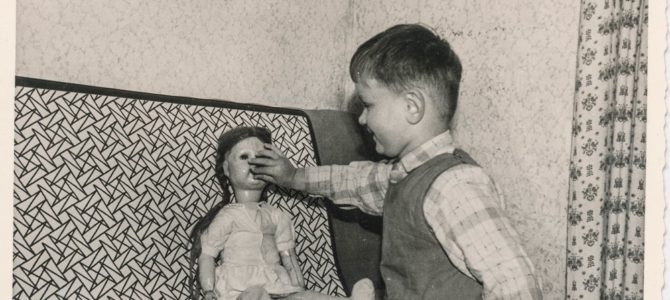
A new report published by the Proceedings of the National Academy of Sciences, reported by NBC News, finds children with gender dysphoria prefer activities and objects that are stereotypical of the opposite sex.
“These findings suggest that children might not be simply learning about gender based on what their parents tell them about their own gender or how they treat them early on (which would be about the gender associated with their assigned sex),” the report says. Instead, the report implies, gender dysphoric children’s sense of being the opposite sex arises early and thus seems to be innate.
The study’s author noted, “There is almost no difference between these trans- and cisgender [non-transgender] kids of the same gender identity — both in how, and the extent to which, they identify with their gender or express that gender.”
To conduct this research, the team traveled to families in Canada and the United States for interviews that lasted about one hour. The study interviewed 317 transgender children aged 3 to 12, 316 children of the same age-range who accept their biological sex, plus 189 of the transgender children’s siblings. All of the children comfortable with their sex lived in the Seattle area and were interviewed with the same questions.
The project is part of a larger effort known as the TransYouth Project, which aims to increase the study of transgender identity in children. The project has been championed by psychologist Kristina Olson, who won the prestigious Alan T. Waterman Award by the National Science Foundation, putting $1 million towards this effort. This “groundbreaking” study will be the foundation of continued research and a resource for professionals and families working with transgender children.
Study Contradicts Itself, Exudes Bias
The study does, however, ignore some striking concerns and makes remarkable assumptions that should be addressed. Study author Selin Gülgöz said the study was limited in scope due to the fact that all of the transgender children were already moving towards increased identification with the opposite sex and lived with families that encouraged their dysphoria.
She notes this means the study’s conclusions might not apply to children who do not live in families who do not enable feelings of gender dysphoria. Interviewing children aged 3 to 12 who have already adopted an opposite-sex gender identity to determine a biological origin of transgender identity is, on its face, biased.
Asking a child who already assumes the role of the opposite sex if he prefers social identifiers like clothing and toys associated with that sex is not an effective method of understanding if these preferences are inherent. Yet Dr. Stuart Chipkin of the University of Massachusetts-Amherst concluded the study “helps to confirm the unique and separate reality of gender and how it is distinct from biological sex and socialization.”
“It supports the idea that gender is inherent and separate from biological sex which would seem to then come down on the side of nature as opposed to nurture,” he added. But how exactly do the social preferences of children already acting transgender in public help us understand the nature of gender and biological sex?
Please Stereotype Yourselves
The researchers attempt to address this by arguing that the children were treated as their “assigned sex” for a time before their behavior and preferences caused their parents to recognize their conflicting gender identity. They reason that if gender preferences were indeed socially constructed, then the children would have adopted the preferences imposed onto them by society until that point. They state that the study shows no difference in preferences between trans or biologically affirming children of the same age group in the same gender identity category.
The researchers asked girls aged 3 to 12 what toys, clothing, and other gender stereotypes they preferred, then asked boys who identify as girls the same questions. Both groups provided identical answers.
The assumption here is that toys, clothing, or color preferences are inherently biological and strictly binary: Boys like trucks and the color blue, and girls like dolls and the color pink. This conflicts with decades of liberal and feminist argument in favor of gender neutrality and against “gendered” toys and clothing.
In an article on fatherhood by the NYC City Dads Groups titled “Boys Playing with Dolls Helps Prepare Them to be Nurturing Fathers,” the argument is clear. The author states, “How do we expect men to become active and engaged dads if boys are still be teased for playing with baby dolls? How do we expect discrimination and gender stereotypes against females to disappear if we still reinforce those macho, stoic roles for males?”
The website for UN Women, an entity of the United Nations, likewise challenges gender stereotypes, arguing, “Gender is not about biological differences between the sexes, rather, it’s a social construct—people define what it means to be a boy or a girl, and these social conditionings often expect children to conform to specific and limiting gender roles and expectations from a young age.”
The Annual Review of Psychology published an in-depth article discussing gender stereotypes, summarized helpfully with the following: “Empirical studies show that gender stereotypes affect the way people attend to, interpret, and remember information about themselves and others.”
So, which is it? Do we define a person by gender stereotypes or not? How do we encourage parents to give dolls to their sons and trucks to their daughters if those behaviors are considered scientific evidence of gender dysphoria? What happened to LGBT advocates and feminists arguing against strict gender roles?
It’s Innate, But It Might Change Anyway
The final and most important aspect of this study that should be concerning is the absolute reliance on young children supernaturally divining their own nature in spite of their physical selves. The study notes, “Gender expression or identity for some of them might shift in the future, or their level of support and affirmation might change.”
If this is the case, then how can they advocate for an inherent gender identity when they recognize it can change over time? The study authors go to great lengths in attempting to prove that the transgender children’s identity was not influenced in any way by their parents, although their core study group fell within a small population of parents willing to transition their kids as young as age three.
We’re seeing an ever-growing demand for narrative-confirming studies rather than scientific analysis that determines reality based on empirical evidence. The social sciences seem determined to validate gender dysphoria as a natural and normal function of human development. Regardless of how conflicting their data is, they will find a way back to that conclusion.
This Undermines Homosexuality
LGBT advocates who hold this study in the air as proof of inherent gender identity fail to realize they are arguing against advocates of inherent sexual orientation who have long insisted gender stereotypes do not determine sexuality.
In truth, this study erases gay people entirely by implying any gender non-conforming behavior in young children is evidence of transgender identity which requires altering a child’s persona and physical body over time. If it were to become widely accepted and practiced, a large percentage of gay individuals would be denied the chance to grow up into healthy gay adults. Instead, they would be forced to live as heterosexual versions of themselves in opposite-sex-mimicking bodies. Once again, we see the left rip out the seams of their patchwork ideology to force conflicting ideas.
Decades of research following transgender youth into adulthood have shown upwards of 90 percent growing out of their dysphoria naturally, with one study showing an 80 percent desistence rate. Advocates argue the definition of what it means to be transgender have changed and therefore previous studies incorrectly identified participants as transgender, but with the current standard of proof they provide it is difficult to accept this argument.
What we are seeing is advocacy forcing science into the direction they want, with very little financial incentive for pushing back. But it is important to hold these advocates accountable for their arguments. It is not enough to hide behind scientific studies when these studies are little more than harmful social activism.









